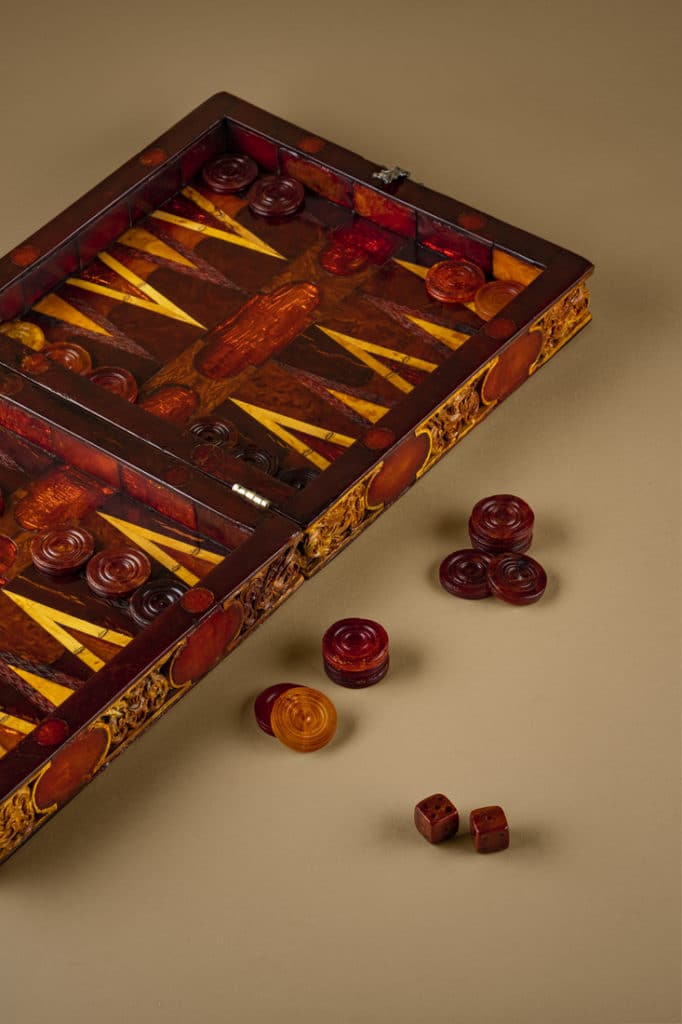Open your diaries and make a note of these dates: from 18th October to 16th December 2023, Galerie Kugel invites you to discover an exhibition dedicated to Baltic amber. Fifty masterpieces dating from the 16th to 18th centuries, patiently assembled by one of Paris’s finest galleries, will be unveiled to the general public. Not to be missed!

Galerie Kugel / Paris © Jérôme Galland
1- A brief history of amber from the Baltic Sea
Amber, and more specifically Baltic amber, is a fossilised resin from a coniferous tree called Pinus succinifera. This tree is particularly well adapted to Scandinavia and northern Europe. A geological process lasting several million years gradually transformed the resin-filled sediments into amber, moving them from Scandinavia to the Sambia peninsula, which you can locate more easily by pinpointing the town of Kaliningrad (Russia).
This area is also one of the biggest sources of amber production. Before it was extracted on a more industrial scale, amber was first collected on beaches following storms. It is still possible to find it on the Baltic coast, around Rügen or Usedom for example.
Amber has been known for thousands of years. It is estimated that trade in amber around the Baltic began around 4000 BC, during the Neolithic period. There were also amber trade routes. There are many examples of preserved objects around the world.
I particularly like the Etruscan and Greek pieces on display at the Getty Museum in Los Angeles. I also like the superb ring (2nd century AD) that was on show at the École des arts joailliers during the exhibition devoted to the Ladrière Collection.

Small bowl decorated with figures mounted in enamelled gold. Attributed to Johann Caspar Labhart (active 1695-1726). Made in Kassel, circa 1690. The mounting by Reinhold Vasters, circa 1870. From the collection of Baron James de Rothschild.
© Courtesy Galerie Kugel / Paris
2- From amber routes to the supremacy of Gdansk
Used since Neolithic times, amber from the Baltic is a valuable commodity, so it was traded for decorative objects, jewelry, figurines and even incense. While there were probably several routes that supplied all of southern Europe and the Arabian Peninsula, it is the one that ran from the Baltic to the Mediterranean that seems to be the best known.
As early as the 1st century, the origin of amber was clearly defined by Pliny the Elder in his “Natural History”. It was already thought to have protective properties, and the emperor Nero gave it to his favourite gladiators. The amber routes all passed along the southern coast of the Baltic, particularly where the city of Gdansk (also known as Danzig) was founded. The various Viking tribes who inhabited the region at the time acquired indisputable knowledge and expertise in amber working.
It was not until the 13th century that the situation changed. Before 1230, the Duke of Mazovia enlisted the services of Teutonic knights returning from the Crusades to conquer and unify the region. A century later, the knights controlled the region and the Baltic amber trade, imposing strict controls. However, several merchant towns did not see it that way, and the Hanseatic League was founded in 1356. Gdansk became oneof its members and amber continued to be used as a bargaining chip here.
At the end of the 14th century, amber workers joined together to form guilds. The first was founded in 1477 in Gdansk, soon followed by other cities. It was at the same time that these same workers obtained the right to settle in this city, making it a historic centre for the working of this material.
From the first half of the 15th century, the Duchy of Prussia controlled the amber trade, but granted a historic advantage: the trade in raw Baltic amber was delegated to a merchants’ syndicate led by Paul Jaski. From then on, the region’s predominance would not be questioned for several centuries. Amber became a veritable object of power and the material of choice for diplomatic gifts.
Game box complete with counters, two dice and chess set. By Michel Redlin. Made in Danzig, circa 1680.
© Courtesy Galerie Kugel / Paris
3- Galerie Kugel
The Kugel family’s involvement with objets d’art began in Russia at the end of the eighteenth century with Elie. Joseph, his son, set up a shop in Minsk dedicated to clocks and jewelry, not forgetting goldsmithing. This was followed by a shop in St Petersburg. It was Joseph’s grandson Matias who ran it. The family left Russia in 1924 and settled in Paris, France. The gallery moved address several times, but in 2004 it finally settled in the sumptuous Hôtel Collot.
Built in 1840 for Jean-Pierre Collot, then director of the Monnaie de Paris, it was designed by the star architect of the era, Louis Visconti. Located a stone’s throw from Concorde, facing the Seine, it is a neo-classical building in all its splendour. It reflects all of Visconti’s admiration for ancient Rome.
Collot made it his private residence and a showroom for his collection of paintings and statues. On his death, his collection and the building were sold and the hotel became the Spanish embassy. After many lives, the Kugel family moved in with their remarkable collection. This place, open from Tuesday to Saturday, is well worth a visit. The Baltic amber exhibition at the end of 2023 will be an excellent opportunity for you to visit it if you missed the exhibition on the art of Piqué.

Small mug in translucent milky amber mounted in gilded silver. By Georg Schreiber. The frame by Andreas Meyer (Master in 1608-1647). Made in Königsberg, circa 1610. © Courtesy Galerie Kugel / Paris
See you soon!











